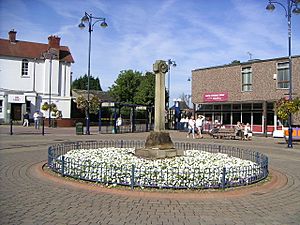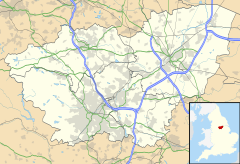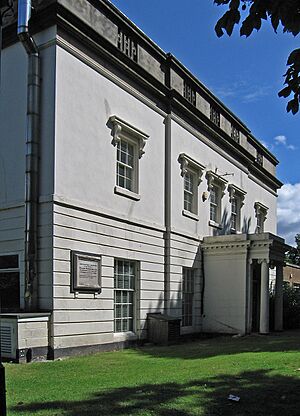Wath upon Dearne facts for kids
Quick facts for kids Wath upon Dearne |
|
|---|---|
 The Market Cross, Montgomery Square, Wath-upon-Dearne |
|
| Population | 16,964 (cite 2021 census) |
| OS grid reference | SE438008 |
| Metropolitan borough |
|
| Metropolitan county | |
| Region | |
| Country | England |
| Sovereign state | United Kingdom |
| Post town | ROTHERHAM |
| Postcode district | S63 |
| Dialling code | 01709 |
| Police | South Yorkshire |
| Fire | South Yorkshire |
| Ambulance | Yorkshire |
| EU Parliament | Yorkshire and the Humber |
| UK Parliament |
|
Wath upon Dearne (often called Wath for short) is a town in South Yorkshire, England. It's located south of the River Dearne, about 5 miles (8 km) north of Rotherham. It's also nearly halfway between Barnsley and Doncaster. In 2011, about 11,816 people lived there. Wath is connected to Saint-Jean-de-Bournay in France as a twin town.
Contents
History of Wath
Wath has a long history, going back to the time of the Normans. It was mentioned in the 1086 Domesday Book as Wad and Waith. For many years, it was a small farming village. It sat where old roads from Doncaster to Barnsley and Rotherham to Pontefract met. North of the town, there was a place to cross the River Dearne. This is why the name "Wath" might come from old words meaning "ford" or "wading place."
In 1312–1313, Wath was given a special permission called a royal charter. This allowed it to hold a weekly market and a yearly fair. These events stopped for a while but the market started again in 1814.
Before 1974, Wath was part of the West Riding of Yorkshire. In the mid-1800s, the town had a horse racecourse. You can still see parts of it today between Wath and Swinton. A famous poet named James Montgomery once lived here. He called Wath "the Queen of Villages" because it was so pretty and rural.
Coal Mining in Wath
Wath changed a lot when coal mining grew in the 1800s and 1900s. The town is built over the South Yorkshire coalfield. People had been digging for coal here for centuries. There were many high-quality coal seams close to the surface. As factories grew, the demand for coal increased. More people moved to Wath, and the town grew around the coal mines.
To help move the coal, the Dearne and Dove Canal was opened between 1798 and 1804. It went through Wath and was sometimes called the "Bay of Biscay." The canal stopped being used in 1961. Today, many roads, like Biscay Way, follow where the canal used to be.
By the 1900s, there were huge coal mines like Wath Main and Manvers Main. After the Second World War, the mines near Manvers became a big complex. It included coal preparation and a plant that turned coal into coke. This plant caused a lot of air pollution for miles around.
Wath and the Railways
Trains soon became the main way to transport coal. Wath upon Dearne became a very important place for moving goods by rail. The Wath marshalling yard, built in 1907, was one of the biggest and most modern in the country. It was a key part of the Manchester-Sheffield-Wath electric railway, which moved large amounts of coal.
Wath used to have three railway stations: Wath Central, Wath (Hull and Barnsley), and Wath North. Wath North was the last to close in 1968. There's been talk of opening a new station nearby at Manvers.
The Decline of Coal Mining
In the 1980s, the coal mining industry in Britain faced a big decline. This was due to changes in government policy. This had a huge impact on Wath and other local industries. It caused many problems for the people living there.
The 1985 miners' strike started because a nearby mine, Cortonwood Colliery, was going to close. Wath and the whole Dearne Valley area were classified as poor. They received money, including funds from Europe, to help rebuild. From the mid-1990s, this money helped the area recover. Much of the land once used by mines and railway yards was turned back into countryside. New light industrial and office parks were also built. This has brought some jobs and economic growth back to Wath.
Wath Today
Today, Wath upon Dearne is still recovering from the end of coal mining. The town center is around Montgomery Square. Here you'll find the main shops, the library, and the bus station. Nearby is the old All Saints Church, Wath Hall, and Montgomery Hall.
While the area felt very rural after the mines closed, new large distribution centers are now being built. These bring back an industrial feel, but without the pollution that coal mining caused. Big clothing companies like Next have opened warehouses here. Many new homes are also being built on land that used to be industrial.
The Wath Festival is a popular event held around the early May bank holiday. It's a folk and acoustic music and arts festival that started in 1972. It now hosts famous musicians from the folk and world music scene. Most big concerts are held at the Montgomery Hall Theatre. The festival supports young artists and includes dancing, street performances, and children's events. A parade goes through Montgomery Square, ending with a tradition of throwing bread buns from the church tower.
The RSPB's Old Moor nature reserve is about a mile north-west of Wath. It's a wetland area created when the land sank due to mining. It's a great place to see birds and wildlife.
Sport in Wath
Wath Athletic F.C. was a local football team from the 1880s until the Second World War. They even reached the first round of the FA Cup in 1926. Since the 1950s, Wath hasn't had a major football team. However, it does have a Rugby Union team that plays in Yorkshire Division 2.
Education
Wath has four primary schools for children aged 3 to 11: Our Lady and St Joseph's Catholic Primary, Wath Central Primary, Wath C of E Primary, and Wath Victoria Primary.
There are two secondary schools. Saint Pius X Catholic High School is for ages 11 to 16. The larger Wath Academy has a sixth form and teaches students aged 11 to 18. Both schools welcome students from a wider area.
Dearne Valley College, a large college for further education, has its main campus in Manvers. It also has a smaller campus near the town center.
Media
Local news and TV shows for Wath come from BBC Yorkshire and ITV Yorkshire. You can also listen to local radio stations like BBC Radio Sheffield, Greatest Hits Radio Yorkshire, Heart Yorkshire, Capital Yorkshire, Hallam FM, and Rockingham Radio. The local newspaper is the Rotherham Advertiser.
Transport
|
Wath-upon-Dearne bus station
|
|
|---|---|
| Location | Montgomery Road, Wath-upon-Dearne town centre Rotherham (S63 7RA) England |
| Owned by | Rotherham Metropolitan Borough Council |
| Operated by | Travel South Yorkshire |
| Bus stands | 4 |
| Bus operators | First South Yorkshire, Stagecoach Yorkshire |
| Construction | |
| Parking | No |
| Bicycle facilities | Yes |
The main place for public transport in Wath is the Wath-upon-Dearne bus station on Montgomery Road. It has four bus stands and is next to Montgomery Square and the library. Buses enter from Biscay Way and leave onto Church Street.
The local council owns the bus station. It doesn't have a ticket office, waiting room, or toilets.
Bus Services
As of 2021, here are some of the bus routes from Wath:
| Stand | Route | Destination |
|---|---|---|
| WS1 | 22X | Barnsley via Wombwell |
| 226 | Barnsley via Wombwell and Stairfoot | |
| WS2 | 220 | Cortonwood via West Melton and Brampton Bierlow |
| WS3 | 220 | Mexborough via Manvers and Swinton |
| 226 | Thurnscoe via Bolton-upon-Dearne and Goldthorpe | |
| WS4 | 22a, 22c | Rotherham (circular route) via Manvers, Swinton, Rawmarsh and Parkgate |
| 22X | Rotherham via Manvers, Rawmarsh and Parkgate | |
| 72, 72a | Chapeltown via Manvers, Elsecar, Hoyland, Tankersley and High Green |
Famous People from Wath
- David Bret (born 1954) – A writer who writes about famous people in entertainment. He went to Wath Grammar School.
- Rob Dawber (1956–2001) – A scriptwriter for the film The Navigators.
- Simon Farnaby (born 1973) – An actor who plays characters in the CBBC show Horrible Histories.
- William Hague, Baron Hague of Richmond (born 1961) – A former leader of the Conservative Party and government minister. He was a student at Wath Comprehensive School.
- Peter Hardy, Baron Hardy of Wath (1931–2003) – A long-serving local Member of Parliament (MP) for the Labour Party. He was born and grew up in Wath.
- Daisy Makeig-Jones (1881–1945) – A sculptor for Wedgwood pottery. She was born in Wath.
- William Keble Martin (1877–1969) – A botanist and artist who drew plants. He was also a vicar in Wath. A street is named after him.
- Ian McMillan (born 1956) – A poet often called the Bard of Barnsley. He went to the secondary school in Wath.
- James Montgomery (1771–1854) – A Scottish poet and newspaper editor who lived in Wath. Montgomery Hall and Montgomery Square are named after him.
- Sir Charles Curran (1921–1980) – He was the Director-General of the BBC from 1969 to 1977. He was educated in Wath.
- George Robledo (1926–1989) – A Chilean footballer who played for teams like Newcastle United. He scored the winning goal in the 1952 FA Cup final.
- Ted Robledo (1928–1970) – George's brother, also a footballer who played for Newcastle United.
See also
 In Spanish: Wath-upon-Dearne para niños
In Spanish: Wath-upon-Dearne para niños




